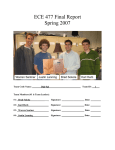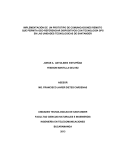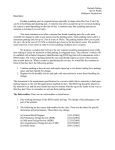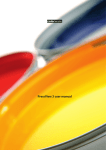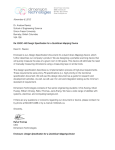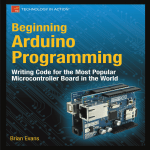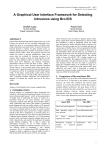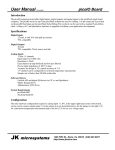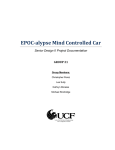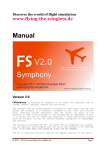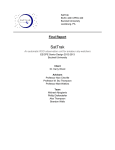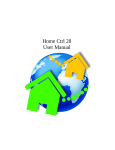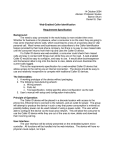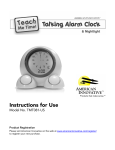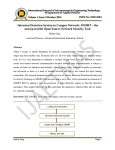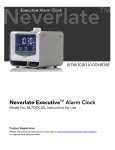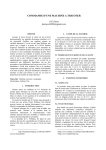Download Final Report
Transcript
Senior Design Project 2013 – ClockAide 1 ClockAide Joel Jean-Claude, Sachin Honnudike, Anita Ganesan, Eric Moore Abstract — ClockAide is an interactive educational system devised to help a specific group of students with special needs from West Springfield Middle School learn how to read and set time. In addition, the device provides the students with a quiet environment to practice entering their lunch identification numbers. The design stemmed from a presentation given by their teacher, Megan Ferrari, at the University of Massachusetts Amherst. She often encounters obstacles when trying to teach her students how to tell time and proposed our team to take lead on finding an innovative solution to assist her. The students learn how to tell time using our three - mode system which prompts them with questions of varying difficulty. Our electronic device will be simple, and user friendly and will ultimately allow students of all levels learn how to read and set any analog clock. In addition to this, Ms. Ferrari proposed other situations that her students found hindering. One place was in the lunchroom. These students must get lunch ten to fifteen minutes early so that they can focus on punching in their lunch ID numbers and get their lunches without feeling overwhelmed by the other students in the school. We believed we could also help the students with this issue as well and implemented it within ClockAide. With our detachable keypad, we can assist students with entering ID numbers by including a login system. By extension, our group is able to extend this functionality through the use of a tracking system. It records activity data like session length, response in the quiz modes, the student lunch numbers, etc. The data can be accessed externally as an Excel spreadsheet, which makes it possible for Ms. Ferrari to see how students are using the device, their progress, program lunch IDs for new students. social studies teacher at West Springfield Middle School says that, “If kids want to know the time, they pull out their cell phones” [25]. In addition, teachers now see that young students have no idea how to read an analog clock since they are mostly exposed to digital clocks at home.1 Right now, there are websites and some types of toys dedicated to helping children read or know the general hour it is during the day. Along with this, there are two types of educational toys that have been on the market similar to the one that we are producing. The first is named the “Onearoo” dual clock and nightlight which only tells time by the hour for children but continues their dependence on adults to tell them the correct time. Another device similar to our design is the “Momo Clock” which is a sleep trainer for young children. This clock tries to implement a regular sleep cycle for small children by showing an image of a sleeping monkey at night to teach the child that they should be sleeping if the eyes are closed.2 Created around 2008, these are the most recent devices produced and the most popular so far.3 Megan Ferrari, the teacher we are working with in West Springfield, informed us that she teaches the students with cardboard clocks but are seeing that they have difficulty with telling times due to the angle of the hands. In addition to this, she also told us that the position of the minute and hour hands of the clock confuse the children and continuously ask her for assistance when staring at the clock. Our end goal is to allow the students to gain confidence and independence while they use our device and create a sense of accomplishment when they start reading the time off an analog clock. The integration with intelligent quiz logic within our device sets our product apart from anything else on the market. When it comes to the clock portion of our device, the social impacts of our device could be considerable. While the lunch ID portion is to specifically help the students of West Springfield, our product could also help students around the country learn this necessary skill. I. INTRODUCTION ClockAide is an educational device in which we use a keypad and a three-mode user interface to solve a specific problem in a class of students with special needs at West Springfield Middle School. However, it can also be applied to students all around the nation who need help reading and setting time. This presents a significant problem as every child needs to learn how to read and set an analog clock, but many have trouble with this concept. Colleen Steele, a 1 "Massachusetts." The Republican. N.p., n.d. Web. 02 Dec. 2012. <http://www.masslive.com/news/index.ssf/2009/12/teachers_say_children _are_beco.html>. 2 "Sleeptrainer Clock - Momo Monkey." - UrbanBaby. N.p., n.d. Web. 02 Dec. 2012. <http://www.urbanbaby.com.au/Sleeptrainer-ClockMomo-Monkey>. 3 "American Innovative." - Company History. N.p., n.d. Web. 02 Dec. 2012. <http://www.americaninnovative.com/about/>. Senior Design Project 2013 – ClockAide II. REQUIREMENTS A. Requirements List The following is a list if the requirements set by the group on this project: 1. 2. 3. 4. 5. Device will speak and display the current time to user when prompted. Device will allow user to practice reading and setting time. Device will allow users lacking fine motor skills to turn knobs for easy setting of the hands. Device will take user input through the keypad and display the time on the clock. Device size will not obstruct the normal use of the classroom and be approximately the size of a students' desk. Each requirement plays an important role in ClockAide's success in helping the students of West Springfield. Requirement 1 emphasizes the need for the student to always know the current time rather than constantly asking their teacher. Requirement 2 emphasizes the user ability to practice reading and setting arbitrary times. Requirement 3 allows every student to be able to use the device without struggle especially when testing their skills during Read and Set modes. Requirement 4 demonstrates the communication between the keypad and stepper motor. Requirement 5 shows the importance of an unobtrusive design with respect to the other individuals that interact within the classroom including other students and staff. III. DESIGN A. System Overview To address the challenge of teaching time to children, our group proposed ClockAide, a device that will interact with a child in a similar way that teachers do. It features two main modes, Normal and Quiz. In normal mode, ClockAide operates like any other standard wall clock, with an additional feature. Any user can press the appropriate key during this mode, and the current time will be spoken out. This allows the children in West Springfield to have the ability to find out what the time is, without asking the teacher. Quiz mode is composed of two sub-modes: Read, and Set. All modes of operation are described in further detail in the next section. This project is primarily tailored to a class at West Springfield Middle School, but can be expanded for general use to students in kindergarten through second grade. To build ClockAide, our group employed embedded system technology to implement the features defined above. Using the Arduino platform, our group designed two modules that would be used in the system. First was the stepper motor circuit, whose purpose is to run the analog display the user sees to read the time. The second is the keypad, which is used to log in, switch modes, and interact with ClockAide 2 in Read Mode. Using the Raspberry Pi, our group extended keypad functionality to include a data logging system which is described in section H. This provided a platform to combine hardware and software to construct the analog display, speech prompts, intelligent quiz logic, and keypad functionality. Our design can be broken down into primary components such as the interface, activation, stepper motors, etc. The following sections will go through the details of our design by breaking it down into each component. B. Activation 1) Normal Mode - This modes' primary function is to display the current time. If a student is interested in knowing what the time is, they can press the Normal mode button on the front of the device, and ClockAide will output an audio file. 2) Read Mode - Tests the cognitive abilities of the student. In this mode, the Raspberry Pi chooses an arbitrary time, and prompts the user to submit a response through the keypad. If the answer is correct, ClockAide acknowledges this, and gives the user the choice to try again. If the answer is incorrect, ClockAide will give the user two additional attempts to achieve the correct answer. If both are unsuccessful, ClockAide will speak out the correct time. 3) Set Mode - In this mode, the device chooses an arbitrary time displayed on the keypad and thus prompts the student to submit a response by moving the two knobs controlling the hour and minute hands. If the answer is correct, ClockAide acknowledges this, and gives the user the choice to try again. If the answer is incorrect, ClockAide will give the user two additional attempts to achieve the correct answer. If both are unsuccessful, ClockAide will speak out the correct time. A. Stepper Motor and Knobs Stepper motors are brushless DC electric motors that divide a full rotation into a number of equal steps. In our design, we make use of two unipolar stepper motors (one driving the hour hand and the other driving the minute hand) in order to achieve a good representation of time and also to enable us control the arms of the clock using two independent knobs. In a traditional clock, both hands are moved by one motor but we found it easier for students to learn when the hands move independently from each other. This design choice was made bearing in mind the relatively simpler complexity of the driver circuit of the unipolar stepper motor versus that of a bipolar stepper motor. Both of these motors have full rotations that are divided into 200 steps. In order to translate the number of steps moved by the Senior Design Project 2013 – ClockAide motor to a time, a C++ library was written along with its corresponding header file. This library primarily contained logic to drive the motor and to move the motor by a specific number of steps. In Normal mode, both motors move sequentially to provide a correct display of time. In Read mode, the position of the motors is set by the Raspberry Pi to enable the student read the time and in Set mode the motors are controlled by knobs, used by the student to set the time. The stepper motors use optical sensors to mark a reference point for rotation. This reference point is set to 12 (noon). This is required for the proper operation of Set mode. These motors can rotate either clockwise or counterclockwise. It is preferred, however, that the students set the time in the clockwise direction. Fig. 1 The two unipolar stepper motors and the driveshaft system that allows the hour and minute hands to move independently. B. Keypad The keypad is primarily used to allow the student to practice entering their lunch identification numbers without getting overwhelmed. When a student starts with ClockAide, he or she must enter their identification number to log in. This gives them a chance to practice entering their ID in a quieter setting. In addition, the keypad also acts as a second input for the student to choose a specific mode. By entering either a 1, 2 or 3 (Normal Mode, Set Mode or Read Mode, respectively) the student enters that specific mode. In Normal mode, the student can press any number on the keypad to hear the current time. During Set mode, this procedure will be used to enter responses. After the student has been prompted to set the clock to a specific time, they will use the knobs located on the face of the device to move the hands of the clock to the proper time. For Read mode, ClockAide will move the hands to an arbitrary time prompting the student to dial their response on the keypad. To make the keypad operational, it had to be reverse engineered. This part was purchased from a private vendor, so it did not include proper documentation, or power cables to operate it. Upon detailed inspection, the keypad consisted of three main parts: a button matrix, an LCD screen, and a 3 microcontroller working as an interface for the buttons to the display. For our purposes, the button matrix was repurposed to work with the Arduino Pro microcontroller. We noticed that the matrix mapping of our keypad was much different than that used by the lunch room at the middle school and therefore, we had to re-engineer it which took a bit of time. This particular keypad was chosen because it was the only one the group found that closely resembled the one at the lunch room at West Springfield Middle School. The buttons are soft to the touch, and are clearly labeled. Our group was not able to obtain an exact model because the extras were discarded and would require us to pay around 300 dollars to replace. Fig. 2 The keypad and LCD setup with the Arduino Pro shown above the casing. The Arduino Pro is a much smaller version of the traditional Arduino prototype board. The Arduino Pro features the same pin layout and Atmega processor. The keypad matrix and LCD screen will be soldered onto the Arduino Pro and integrated into the case. C. Audio System Ms. Ferrari recorded all of the hours, minutes (5-minute intervals), and wildcards (e.g: o’clock and noon) in a single audio file. Megan’s voice was used so that the audio output will be natural and similar to what the students would hear when they practice in class with Ms. Ferrari. The opensource audio editor Audacity was used to process the audio file and remove background noise. The file was amplified prior to being broken into separate MP3 encoded files for each hour and minute. These MP3 files were placed on a micro SD card into separate folders (e.g: hours, minutes, wildcard). D. Additional Functionality 1) Identification Feedback This is the mode that is primarily driven by the keypad. The child will enter his or her ID number, and the system Senior Design Project 2013 – ClockAide provides a response through the LCD screen. All the student ID numbers would be stored in an SD card as a CSV file. This file can be edited by the teacher through Microsoft Excel, allowing her to update the list every year when she gets new students. This allows the teacher to keep track of a students progress and also allows Set and Read modes to function more efficiently. E. Power Using multiple embedded systems for the ClockAide posed a challenge for power distribution. The Raspberry Pi and Arduino Uno need a 5 volt power supply, while the two stepper motors require a 15 volt power supply. The speaker and amplifier are powered by a 12 volt power supply. Using a computer power supply (ATX), and a breakout board, the various components can be powered from a single source. A 9W load resistor provides the minimum load necessary for proper operation of the power supply. Since the breakout board maxed out at 12V, the group had to see if the stepper motors could operate at that level. Further testing showed no change in quality of operation of the stepper motors. The motor circuit can be driven at 12 volts. Using a PC power supply also allows for easy mounting into the case. Fig. 3 The ATX breakout board (with a 9W resistor soldered onto the board) connected to the ATX power supply. The 9W resistor provides the minimum load necessary for proper operation of the power supply. The ATX breakout board is designed. The ATX breakout board provides 12, 5, 3.3, and -12 volts output. F. Software The first version of the ClockAide software was written in C++. It featured the basic functionality: Normal, Read, and Set modes. For the integration process, however, it was decided that using Python would be more convenient because Python contains libraries designed for serial communication between devices. This fit well with the ClockAide, since serial communication was required between the Pi, keypad, and stepper motor circuit. 4 For the teacher feedback system described above, a local data logging system was used. It consists of a database (SQLite) that stores the lunch numbers of the students, and records the activity between the two quiz modes. The data recorded includes the session start and stop times, responses entered in read and set modes, and the difficulty of the questions answered. The difficulty of a question is determined from previous discussions with Ms. Ferrari and multiple visits to the school. We observed how the students take in information and what kinds of problems they encounter when working on telling time with their teacher. This data can be exported to CSV format for use in Microsoft Excel, as requested by Megan Ferrari. Using a USB drive, the teacher can extract a copy of the database, and import it into an Excel spreadsheet for analysis. This was made possible using concepts from Software Intensive Engineering (ECE 373), which include version control (GitHub), the iterative development cycle, and basic integration testing. G. Casing Acrylic plastic ordered from McMaster-Carr will be used for the sides and top of the casing. The front and back sides will feature clear acrylic glass so that the electronics and motors inside can be viewed. The bottom of the casing will be plywood. Shelves will created inside the case to house the motors and PCB. The ATX power supply will be mounted to the plywood. The speakers and amplifier will be mounted on the sides. Fig. 5 Outer Design of ClockAide Specification Value Weight Height Length Width Power Supply Keypad 5 lbs 12 inches 18 inches 12 inches 12V DC Detachable Table 1 Design Specifications H. Block Diagram Senior Design Project 2013 – ClockAide 5 After this is done, the user has to organize the routes to his or her preferences. After that, it is suggested to perform a design rules check (DRC), to see if there are any major errors that could prevent the fabrication from being successful. If there errors are found, they are corrected, and the DRC is run again. Otherwise, the PCB design is complete, and ready for fabrication. Fig. 6 Overall system overview. I. PCB Design There are many popular PCB design programs out there today, including Eagle, and PCB Artist. The component that was most in need of a dedicated printed circuit board was the stepper motor circuit. It consists of two stepper motors, two optical sensors, a Darlington array, and an Arduino Uno. A design was created to reduce the size of the circuit, and to provide a simple way to tap power from a breakout board that is used to power the Pi, and the keypad. We found that it may also need to be connected to the RTC. Fig. 8. Schematic. Used to make sure all the connections were present before performing route processing There are many popular PCB design programs out there today, including Eagle, PCB and Artist. The one our group went with was Fritzing, from an open source community in Germany. The reason why we chose Fritzing was because it made it possible for use to create a layout the diagram of the physical circuit on the program, and the software would automatically generate the schematic diagram, and the PCB. This made the drafting process straightforward. Once the circuit was laid out in Fritzing, the schematic was adjusted accordingly to verify that all the necessary connections were present. Fig. 7. Once the connections were verified, the routes were performed using the AutoRoute feature. This is a process where the software creates the electrical connections for all the components of the circuit. Fig. 9. Completed design, with proper routes, labels, and component placement. Another feature of Fritzing is that it provides direct access to fabrication services through the user interface. Senior Design Project 2013 – ClockAide Through the click of a button, the user can prepare an order directly from the Fritzing website, and get it back in two weeks. The drawback to this was the turnaround time, since the board was going to be fabricated in Europe. Since Joel had experience with PCB assembly in the past, he used his contacts to see if he could find a fabricator in the U.S. that could deliver a fabricated PCB faster. He found Advanced Circuits, in Oregon, that not only beat Fritzing's price, but was also within U.S. borders, which helps shorten the turnaround time. 6 To accomplish all our goals, Sachin and Eric had the task of writing the system code to establish communication between the stepper motor and Raspberry Pi. Eric developed the libraries for the stepper motor and worked with Sachin in coding these libraries with a view to implement our unique functionalities. Extensive work was done in calculating various parameters related to how the stepper motors would drive the hands to achieve an accurate representation of time. This code was responsible for the functionality of the Normal and Set modes and well as the audio feedback portion of ClockAide. IV. POWER SUPPLY Using multiple embedded systems for the ClockAide posed a challenge for power consumption. The Raspberry Pi and Arduino Uno need a 5 volt power supply, while the two stepper motors require a 12 volt power supply. Using an ATX power supply, and a breakout board, the various components can be powered from a single source. Since the breakout board maxed out at 12V, the group had to see if the stepper motors could operate at that level. Further testing showed no change in quality of operation, so it was okay to use the 12V setting on the breakout board. V. PROJECT MANAGEMENT A. Team Member Roles Each of the members of our group has a set of skills and strengths that they can contribute their knowledge and also expand their knowledge as well. First off, we made a list of tasks that would allow us to complete our project on time – drawing block and circuit diagrams of different components, writing drivers for specific components, core system code and algorithms, the user interface, hardware device integration, power system design and overall physical implementation – each with divisible sub tasks. As we went through this list, each team member gave their initial idea for how to go about that task and with their initial interest, we were able to start delegating assignments accordingly. We set tasks within the Gantt charts along with corresponding dates of expected completion. By looking at the Fall and Spring Gantt charts we created, we were able to look and see what we needed to have done in time for our deliverables. The deliverables were first discussed amongst the group members and then were established and agreed upon by the review board and our advisor. ClockAide is primary based on the communication between the Raspberry Pi, the stepper motors and the keypad. The position of the minute hand and hour hand depend on the input from the knobs as well as our stepper motor algorithm. In addition, other modes require the Raspberry Pi to output an arbitrary time to either the stepper motors or the keypad. This requires both low level software for the Raspberry pi and devices, and high level software for the positional analysis. Additional functionality including the quiz logic, Read mode and accessing the system through lunch identification numbers were accomplished by Joel and Anita. Finding a keypad suitable for the students to use was one of the big obstacles of this project, and required Anita to reverse engineer the keypad twice throughout the duration of the project. In addition, she also took on the responsibility to complete the design and construction of ClockAide. Joel developed the logic for Normal, Read, and Set modes, so that ClockAide interacts with the user. Initially, it was written in C++, but was later translated to Python to make integration with the keypad and stepper motor system easier. At that point, Joel and Sachin worked on the feedback tracking system, using SQLite, also in Python. Joel worked on storing lunch numbers, session length, and the user responses in the quiz modes, while Sachin worked on building the Question Bank that contains ratings for easy, medium, and hard questions. Both Joel and Sachin worked on automating the process to export the data to Excel and other related work. Each of the team members worked equally on software and hardware sections on each of the components. We debugged each other’s code and eventually had functional software for the stepper motor, audio feedback and keypad components for each subsystem of the ClockAide. VI. CONCLUSION ClockAide provides a fun, educational device for students with special needs in West Springfield Middle School but will also be used to teach people of all levels how to read and set an analog clock. In closing, out project has been a success. We have been able to meet all our original requirements thus far. In reality, we are giving the students the increased independence that their teacher asked us to supply with ClockAide. Senior Design Project 2013 – ClockAide VII. ACKNOWLEDGEMENTS Megan Ferrari – Teacher at West Springfield Middle School She is the direct beneficiary of this project. She reached out to the group at the beginning of the semester and explained what her needs were. Our group chose to work with her. She also invited us to see the children and get feedback on the device. Team ClockAide faculty advisor 2012– Professor T.B. Soules Professor Soules met with our group weekly to discuss ideas, future plans and continuously helped us overcome hindrances in our design. We bounced different concepts with him and took his advice very seriously due to his extensive background and knowledge in Electrical and Computer Engineering. Team ClockAide faculty advisor 2013– Profesor William Leonard Professor Leonard took over as our adviser later on in the year. He provided very useful feedback and checked in with our group weekly to monitor our progress. Instructors / Course Coordinators – Professor Christopher Hollot and Professor Christopher Salthouse These two professors gave us great insight and advice during one-on-one meetings with our group in lab, email correspondence and classroom lectures about different design principles, working productively in a group and prototyping to meet specifications. Senior Design Project Evaluators - Professor Janaswamy and Professor Ciesielski These two professors took time out of their busy schedules to watch and evaluate our progress during each stage of our design. Throughout the process, provided useful feedback during our Preliminary Design Review (PDR) presentation that helped us reshape and re-evaluate different components of our project. Specifically, they informed us on what they expect for the Midyear Design Review (MDR) presentation. SDP Technician - Francis Caron Mr. Caron has been an invaluable resource to all the teams in enrolled in the Senior Design Project course. He has helped us order all the equipment for our project and set up our work station computers. He helped us to keep organized during this year long capstone from the initial idea phase to the final completed design. VIII. [1] [2] [3] [4] REFERENCES G. Boulton-Lewis, L. Wiss, S. Mutch, “Analysis of Primary School Children's Abilities and Strategies for Reading and Recording Time from Analogue and Digital Clocks,” Queensland University of Technology Microchip PIC16C5X Datasheet. EEPROM/ROM-Based 8-bit CMOS, pp. 4, 13, 37 Microchip Corporation. Copyright 2002. Sipex SP233ACP Datasheet. pp. 3. Copyright 2000. Atmel AVR ATMega328 Datasheet. 8-bit Microcontroller with 32Kbytes In-System Programmable Flash. Copyright 2005. 7 [5] Xiamen Ocular GDM1602K Datasheet. No date available. [6] [7] [8] [9] [10] [11] [12] [13] [14] [15] [16] [17] [18] [19] [20] [21] [22] [23] [24] [25] Roberto Guido, 2012-11-23. Arduino – ArduinoBoardUno. Arduino wiki. Available: http://www.arduino.cc/en/Main/arduinoBoardUno Scott Fitzgerald, 2012-10-20. Arduino – Reference | History. Arduino wiki. Available: http://arduino.cc/en/Reference/HomePage?action=diff Paul-Arthur Asselin, 2011-5-5. What's the password? Arduino + keypad. Arduino wiki. Available: http://bildr.org/?s=what%27s+the+password crocboy, 2010-3-8. Connecting an LCD to an Arduino. Instructables.com. Available: http://www.instructables.com/id/Connecting-an-LCD-to-theArduino/#step1 Hacktronics, 2012-11-23. Arduino Character LCD Tutorial. Arduino wiki. Available: http://www.arduino.cc/en/Main/arduinoBoardUno Roberto Guido, 2012-11-23. Arduino – ArduinoBoardUno. Arduino wiki. Available: http://www.arduino.cc/en/Main/arduinoBoardUno Roberto Guido, 2012-11-23. Arduino – ArduinoBoardUno. Arduino wiki. Available: http://www.arduino.cc/en/Main/arduinoBoardUno Stepper Motor, 2012-11-01. Stepper motor - Wikipedia, the free encyclopedia. Available: http://en.wikipedia.org/wiki/Stepper_motor C++ to Python Conversion. 2013-02-27. The Python Language Reference – Python v.2.7.3 documentation. Available: http://docs.python.org/2/reference SQLite Database.2012-2-19. An Introduction to The SQLite C/C++ Interface. Available: http://sqlite.org/cintro.html Mike Chirico, 2013-2-25. SQLite Tutorial: Common Commands and Triggers. Available: http://linuxgazette.net/109/chirico1.html Ramesh Natarajan, 2012-09-20. SQLite3 SQL Commands Explained with Examples. Available: http://thegeekstuff.com/2012/09/sqlitecommand-examples Hobbytronics, 2013-01-24. Raspberry Pi GPIO Pinout. Available: http://www.hobbytronics.co.uk/raspberry-pi-gpio-pinout Ladyada, 2013-02-04. Overview | Adding a Real Time Clock to Raspberry Pi | Adafruit Learning System. Available: http://learn.adafruit.com/adding-a-real-time-clock-to-raspberry-pi Ladyada, 2013-02-04. Wiring the RTC | Adding a Real Time Clock to Raspberry Pi | Adafruit Learning System. Available: http://learn.adafruit.com/adding-a-real-time-clock-to-raspberrypi/wiring-the-rtc Rahul Kar, 2012-2-19. Raspberry Pi Blog: Interfacing 16x2 LCD with Raspberry Pi using GPIO & Python. Available: http://www.rpiblog.com/2012/11/interfacing-16x2-lcd-withraspberry-pi.html HD44780A User Manual, 2013-03-30. pp. 11 Optrex Corporation. SparkFun Electronics. 2006-07-05. SerLCD – Serial Enabled LCD. Megan Ferrari – Teacher, West Springfield Middle School Colleen Steele – Teacher, West Springfield Middle School







